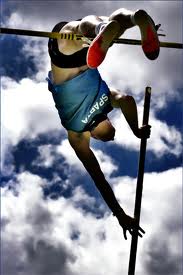I have long searched for a squat related lift that will recruit a near maximum or maximum number of motor units (muscle fibers) without putting the athlete at risk. Executing a 3 rep maximum with a regular back squat puts a lot of weight on the athlete’s back making it difficult to maintain a safe and efficient position.
The drag squat which looks similar to a lunge is a simple single leg squat that requires very little equipment. The following pictures will describe step by step the method of executing the drag squat.
Picture # 1
A wall, a box or chair and dumbbells is all that is required to do drag squats.
Picture # 2
The athlete must first establish the distance from the wall to the front foot. This distance will vary with each individual. The athlete should place the toe of the rear foot up against the wall with the laces down. The thigh of the rear leg should be position vertically while the heel of the front foot is plumb to the knee cap.
Picture # 3
The athlete should measure this distance and place a mark on the floor.
Picture # 4
In executing the drag squat the athlete should assume a balanced position with the weights off the ground.
Picture # 5
The athlete must move his/her hips forward slowly then pause. Similar to a squat the athlete must attempt to maintain his/her back straight and as close to vertical as possible.
Picture # 6
The athlete should then stand up by pushing downward through the heel of the front leg while dragging a passive rear leg. Dragging the leg eliminates the leg’s ability aid in the squatting effort.
Picture # 7
This photo demonstrates a common error to stand up without shifting the hips forward first. The only recourse the athlete has is to push forward with the rear leg and lean forward. This movement decreases the effort needed by the front leg to stand up.
Picture # 8
This photo shows the athlete continuing the effort to stand up. He continues to drag the rear foot until the foot is lifted off the ground.
Picture # 9
The athlete should then extend the front leg completely by extending at the foot, knee, and hip. This extension should be performed in a vertical direction as though he/she were trying to jump upward. As the athlete moves toward vertical the pressure will move from the heel to the toe.
Picture # 10
Another common error is allowing the hips to pass over the foot before extending the front leg. The box is used only to help the athlete catch his/her balance. It is not there for them to lunge on to.









